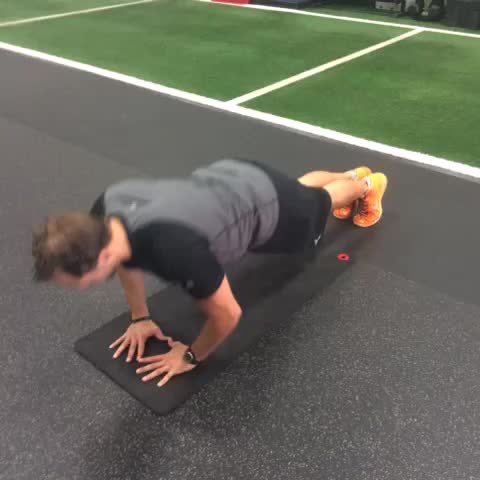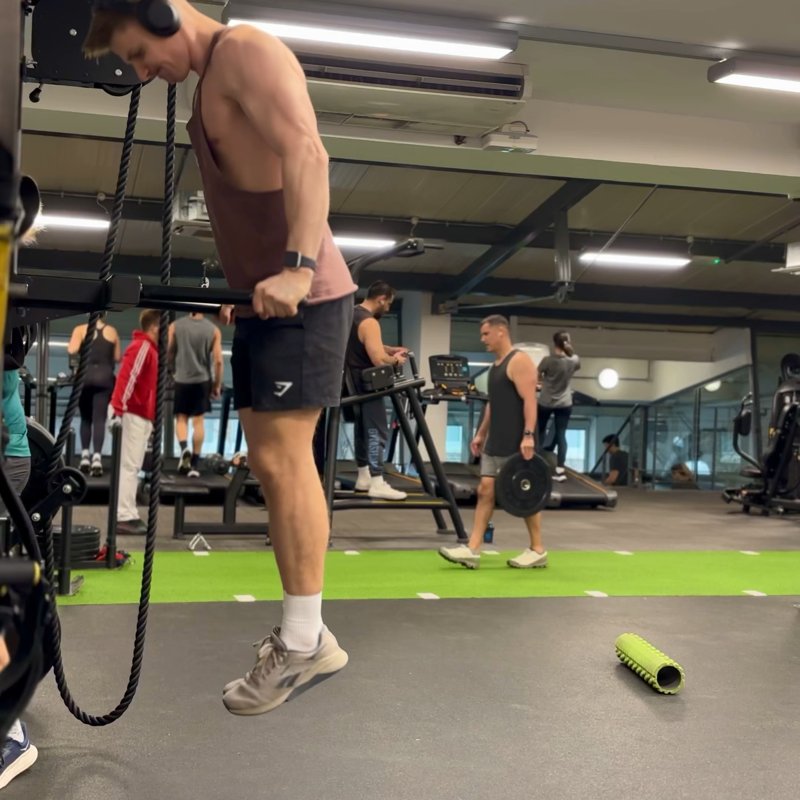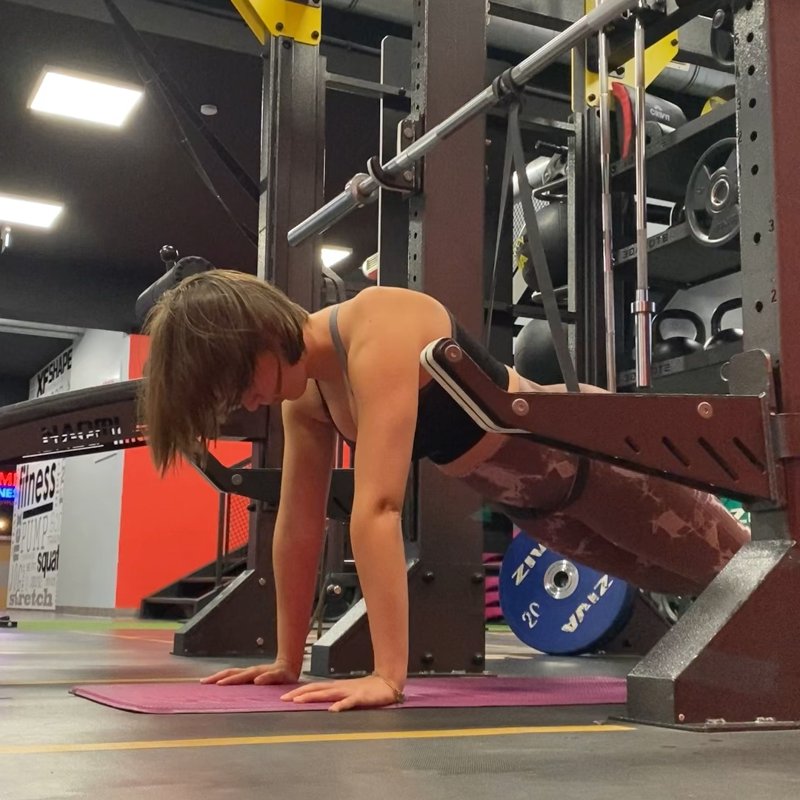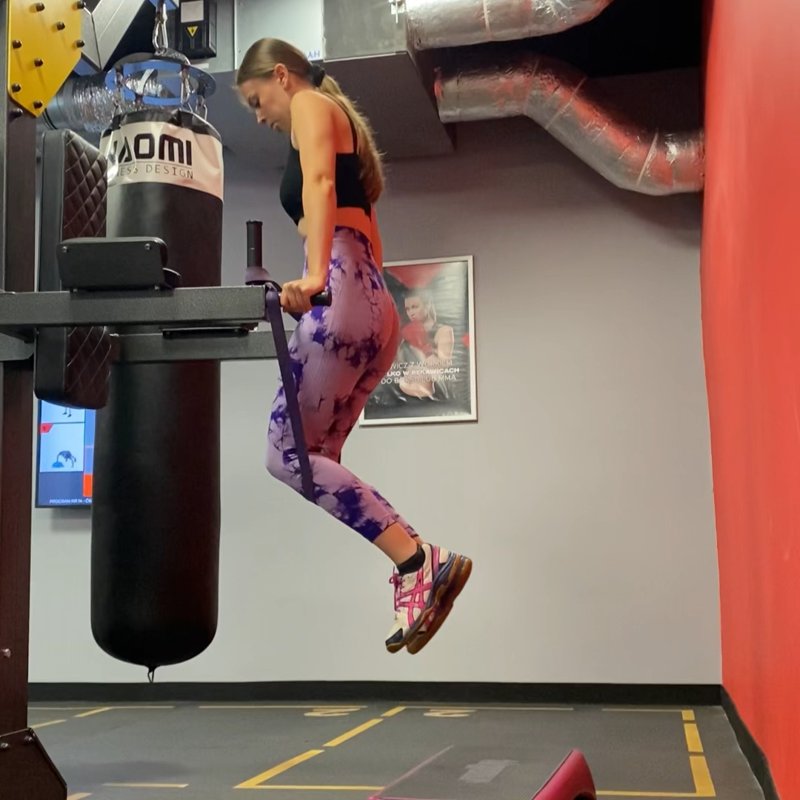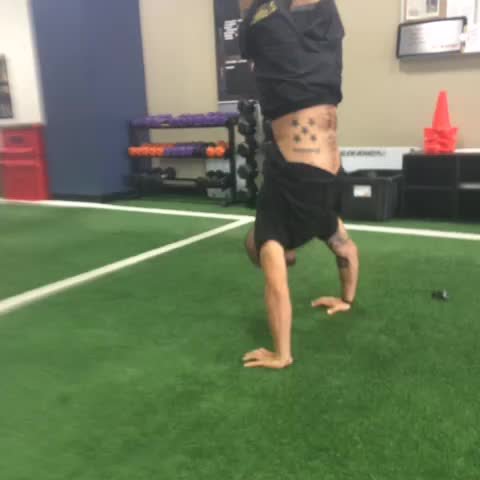Push-Up: The Ultimate Guide
The Push-Up is a fundamental bodyweight exercise that targets the chest, shoulders, and triceps through a pressing movement that involves lowering and raising the body while maintaining a rigid plank position.

Quick Facts
Key Benefit
Comprehensive upper body development without equipment
Primary Muscles
Anterior Deltoids, Pectoralis Major, Triceps
Secondary Muscles
Abdominals, Pectoralis Minor, Quadriceps, Rhomboids, Rotator Cuff
Equipment
bodyweight
Difficulty
Beginner
Type
Strength
In This Guide
Ready to master the Push-Up?
Track your progress, see improvements over time, and build strength consistently.
Download GravitusThe Push-Up stands as one of the most effective and accessible exercises in fitness, serving as both a foundational movement for beginners and a versatile staple for advanced athletes. This compound bodyweight exercise simultaneously engages multiple muscle groups while developing functional strength that transfers directly to daily activities and athletic performance.
What makes the Push-Up particularly valuable is its unmatched versatility. Without changing equipment, you can modify this single exercise to emphasize different muscle groups, adjust the difficulty level, or target specific training goals from endurance to power development. Few exercises offer such scalability—from wall push-ups for beginners to complex plyometric variations for elite athletes.
Beyond muscle development, the Push-Up trains the body as an integrated unit. The rigid position required throughout the movement develops core stability, teaches proper body alignment, and builds awareness of how different muscle groups coordinate during functional movements.
As a foundational movement pattern, mastering the Push-Up provides a gateway to more advanced fitness pursuits. The pressing mechanics translate directly to bench pressing, the plank position develops prerequisite stability for numerous core exercises, and the scapular control is essential for healthy shoulder function across various upper body movements.
Whether you're beginning your fitness journey, looking to enhance athletic performance, or seeking an effective exercise for any setting, the Push-Up offers significant benefits with minimal equipment requirements.
Benefits of Push-Ups
The Push-Up offers numerous advantages that make it a cornerstone exercise in nearly any fitness program.
Multiple Muscle Engagement
Simultaneously works the chest, shoulders, triceps, and core, providing efficient full upper body stimulation in a single exercise.
Functional Strength Development
Builds strength that directly transfers to daily activities and sports that involve pushing movements.
Core Stability Enhancement
Requires maintaining a rigid plank position throughout the movement, developing core strength and body awareness.
Shoulder Health Promotion
Develops scapular stability and control when performed properly, contributing to overall shoulder joint health.
Accessibility and Adaptability
Requires no equipment, can be performed anywhere, and offers numerous modifications to accommodate any fitness level or goal.
Proper Form & Technique
Setup
- Begin in a plank position with your hands placed slightly wider than shoulder-width apart.
- Position your hands directly beneath your shoulders or slightly wider, fingers pointing forward or slightly outward.
- Extend your legs behind you with feet together or slightly apart for stability.
- Establish a straight line from your heels through your hips to your head—avoid sagging or hiking the hips.
- Engage your core by drawing your navel slightly toward your spine without changing your back position.
- Set your gaze slightly ahead of your hands, keeping your neck in a neutral position aligned with your spine.
- Distribute your weight evenly between both hands, maintaining full contact with all fingers and the pad below the thumb.
- Slightly externally rotate your arms so that the creases of your elbows face forward.
Movement
- Inhale as you begin to lower your body, keeping your elbows at approximately a 45-degree angle from your torso.
- Maintain a rigid plank position throughout the movement—your body should descend as a unit.
- Lower until your chest is approximately 2-3 inches from the floor, or until your elbows reach a 90-degree angle.
- Pause briefly at the bottom position, maintaining muscle tension rather than resting on the floor.
- Exhale as you press through your palms, pushing the floor away to return to the starting position.
- Fully extend your arms at the top without locking your elbows, maintaining slight tension in your chest and triceps.
- Keep your shoulder blades proper positioned—avoid excessive protraction or retraction at either end of the movement.
- Repeat for the desired number of repetitions while maintaining form integrity throughout.
Key Form Tips
Body Alignment
Maintain a straight line from head to heels throughout the entire movement, avoiding sagging hips or raised buttocks.
Elbow Position
Keep elbows at approximately a 45-degree angle to your torso, not flared out to 90 degrees or tucked too close to the body.
Breathing Pattern
Inhale during the descending phase and exhale during the pushing phase to maintain core stability and optimize oxygen flow.
Hand Placement
Position hands at a width that feels comfortable for your shoulders, typically slightly wider than shoulder-width for most individuals.
Tension Maintenance
Avoid fully relaxing at either the top or bottom of the movement, maintaining muscle engagement throughout the entire repetition.
Muscles Worked
Primary Muscles
- pectoralis major: The large chest muscle responsible for the horizontal adduction and internal rotation of the arm, which is the primary mover during the pushing phase.
- triceps: The three-headed muscle on the back of the arm that extends the elbow during the pushing phase of the movement.
- anterior deltoids: The front portion of the shoulder that assists with the pushing motion and stabilizes the shoulder joint throughout the movement.
Secondary Muscles
- pectoralis minor: The finger-like muscles along the ribs that protract the scapula and help maintain proper shoulder positioning.
- abdominals: The abdominals, obliques, and lower back muscles work isometrically to maintain the rigid plank position throughout the exercise.
- rotator cuff: The group of four muscles that stabilize the shoulder joint during the movement, particularly during the lowering phase.
- rhomboids: The muscles between the shoulder blades that work to control scapular movement during the lowering and raising phases.
- quadriceps: The front thigh muscles work isometrically to help maintain the straight-body plank position.
Common Mistakes and How to Fix Them
Sagging Hips
Allowing the midsection to drop toward the floor, which reduces core engagement and can strain the lower back. Consciously engage your core muscles throughout the movement, thinking about drawing your navel toward your spine without changing your back position. If necessary, strengthen your core with supplementary exercises like planks before progressing push-up volume. Consider shortening the range of motion temporarily until core strength improves.
Flared Elbows
Allowing the elbows to extend directly out to the sides (90 degrees from the torso), which creates excessive stress on the shoulder joints. Position your elbows at approximately a 45-degree angle from your body, which provides better shoulder joint mechanics. Visualize keeping your elbows pointing backward rather than sideways. If needed, place small markers or tape on the floor as a reminder for proper hand placement that facilitates correct elbow positioning.
Incomplete Range of Motion
Not lowering the body sufficiently or not fully extending at the top, which reduces muscle development and movement integrity. Focus on lowering until your chest is 2-3 inches from the floor and extending to the point where your arms are straight but elbows aren't fully locked. If full range push-ups are too challenging, use an inclined surface for hands rather than reducing range of motion. Track progress by gradually lowering the height of the incline as strength improves.
Head/Neck Misalignment
Looking up or dropping the head down, which places strain on the cervical spine and disrupts proper body alignment. Maintain a neutral neck position by keeping your gaze fixed slightly ahead of your hands on the floor. The back of your head, upper back, and hips should form a straight line throughout the movement. Place a small object on the floor as a visual focus point to help maintain proper head positioning.
Hand Placement Too Wide or Narrow
Positioning hands at extremes that create unfavorable joint angles and reduce effectiveness. Set your hands at approximately shoulder-width or slightly wider, with fingers pointing forward or slightly outward. The precise width can vary based on individual body proportions, but extremely wide or narrow hand positions should generally be avoided until you've mastered the standard technique. Experiment with minor adjustments to find the most comfortable and effective position for your individual structure.
Push-Up Variations
Difficulty Modifications
-
Wall Push-Ups
Performed standing with hands against a wall, providing significantly reduced resistance for beginners or rehabilitation.
-
Incline Push Up
Performed with hands elevated on a stable surface like a bench or step, reducing the resistance compared to standard push-ups.
-
Decline Push-Up
Performed with feet elevated on a bench or step, increasing the challenge by shifting more body weight to the upper body.
-
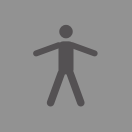
Single-Arm Push-Up
An advanced variation where one arm is used for the pushing movement, creating extreme demands on strength and stability.
Muscle Emphasis Variations
-
Diamond Push-Up
Performed with hands close together forming a diamond shape, increasing triceps engagement relative to chest activation.
-
Wide Push-Up
Performed with hands significantly wider than shoulder width, increasing emphasis on the chest and reducing triceps involvement.
-
Pseudo Planche Push-Up
Performed with hands positioned further down by the hips and fingers pointing backward, increasing anterior deltoid activation.
-

Push-Up Plus
Adding a scapular protraction at the top of the movement, specifically targeting the serratus anterior muscle.
Frequently Asked Questions
The appropriate number of push-ups depends entirely on your current fitness level, training goals, and individual factors like age, body type, and training history. Rather than focusing on arbitrary standards, consider these general guidelines:
For general fitness, most adults should aim to gradually build toward 10-20 consecutive push-ups with proper form. For strength-focused training, fewer repetitions (5-10) with more challenging variations often provide better results than high repetitions of standard push-ups. For muscular endurance, higher repetition ranges (20+) become more relevant.
Military and first responder fitness tests often use push-up counts as assessment metrics, with requirements varying by age and gender. For reference, many military branches expect male recruits aged 17-21 to perform 35-42 push-ups in two minutes, while female recruits in the same age range may need to perform 13-19 repetitions.
Rather than comparing yourself to others, track your personal progress over time. If you can only perform one proper push-up today, aim for two next week. Consistent improvement matters more than meeting arbitrary standards. Remember that proper form should never be sacrificed for higher repetition counts - a few perfect push-ups are far more beneficial than many repetitions with poor technique.
Your chest should approach the floor during push-ups, but complete contact isn't necessarily required for most training purposes. The ideal depth balances maximum range of motion with proper form and shoulder health.
For most people, lowering until the chest is 2-3 inches from the floor (or until the elbows reach approximately 90 degrees) provides sufficient range of motion while maintaining proper shoulder mechanics. Going deeper can potentially place excessive stress on the shoulder joint, particularly if mobility limitations are present.
Some fitness tests and athletic programs do specify chest-to-floor or chest-to-deck (military terminology) requirements, where a brief touch is required for each repetition to count. If preparing for such assessments, practice accordingly while gradually building the mobility and strength required.
Regardless of whether your chest touches the floor, focus on these key elements: maintain a rigid plank position throughout the movement, keep your elbows at a 45-degree angle to your torso (not flared out to 90 degrees), control both the lowering and raising phases, and avoid compensatory movements like arching the back or leading with the head.
If you struggle to maintain proper form with full-depth push-ups, it's better to reduce the depth slightly rather than compromise overall technique. As strength and mobility improve, you can gradually work toward greater depth.
Push-ups and bench press each offer unique advantages, making them complementary rather than competing exercises for upper body development. Neither is universally "better" – their relative effectiveness depends on your specific goals and circumstances.
Push-ups offer superior accessibility (no equipment needed), engage more core musculature due to the plank position, provide greater scapular freedom of movement which can benefit shoulder health, and promote functional strength that transfers directly to many daily activities and sports. They're also highly versatile, with countless variations to target different muscle groups or training goals.
Bench press allows for more precise loading and progressive overload through weight increments, potentially enables greater absolute loading for maximum strength development, isolates chest/triceps/shoulder focus with less core requirement, and offers easier measurement and tracking of progress through weight and repetition records.
For optimal development, consider incorporating both exercises in your training program, either within the same session (often bench press first, followed by push-up variations) or across different training days. For those without access to weight equipment, advanced push-up variations can certainly build impressive upper body strength and muscle development when programmed intelligently with proper progression.
If forced to choose only one, select based on your primary goal - bench press might edge out for pure strength and hypertrophy goals with equipment access, while push-ups win for functional fitness, minimal equipment settings, and balanced development incorporating core stability.
Difficulty with push-ups despite strength in other areas typically stems from specific strength gaps, technique issues, or body composition factors rather than overall weakness. This experience is quite common and can be systematically addressed.
The push-up requires a unique combination of strength components: Your chest, triceps, and shoulders must be strong enough to press approximately 65-75% of your bodyweight (the percentage that loads the upper body in standard push-up position). Your core must activate properly to maintain the rigid plank position throughout the movement. Your scapular stabilizers must function effectively to support proper shoulder mechanics.
If you struggle with push-ups despite feeling strong in other exercises, consider these potential causes: You may have strength imbalances between the muscles involved in pushing movements. Your body composition may create a challenging strength-to-weight ratio for this particular movement. You might lack the specific neuromuscular coordination required for the push-up movement pattern. Core weakness could prevent maintaining proper body alignment during the exercise.
The solution involves a progressive approach: Begin with modified versions like incline push-ups (hands elevated on a sturdy surface) to reduce the percentage of bodyweight you're lifting. Practice plank holds to develop the core stability needed for proper push-up position. Incorporate supplementary exercises like dumbbell bench press, chest flies, and tricep extensions to strengthen the primary movers. Focus on proper technique rather than repetition numbers, gradually progressing to more challenging variations as strength improves.
Most people can develop the ability to perform standard push-ups with consistent practice and appropriate progression steps, regardless of starting point.
Video Demonstrations
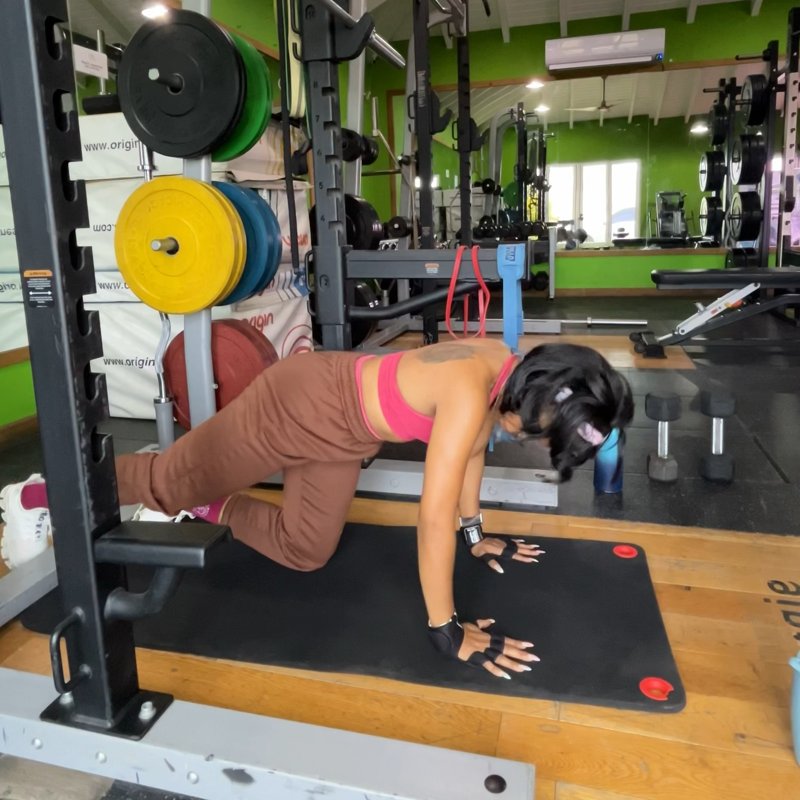
Log in to watch video demonstrations
Login to Watch3 video demonstrations available
Find more video demonstrations in the Gravitus app
Tips from the Community
-

Yeah. It’s a push-up. To work your triceps more, keep your arms parallel to your torso. Switch between different hand widths to be able to go more push-ups.
Track your progress with Gravitus
Download Gravitus to log your workouts, track your progress, and join a community of fitness enthusiasts.

Helpful Resources
One Rep Max Calculator
Find your one rep max for any exercise without maximal testing. Essential for developing effective strength training programs.
Calculate 1RMWorkout Programs
Follow structured workout programs created by fitness professionals to maximize your strength and muscle gains.
View Programs